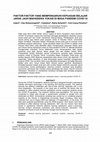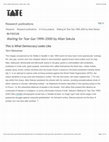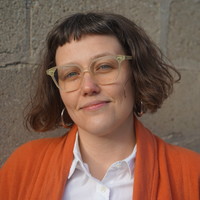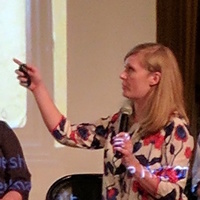Papers by Stephanie Schwartz

Tate: In Focus, 2016
Pada awal tahun 2020 hampir semua negara di dunia mengalami masa pandemi COVID-19 termasuk negara... more Pada awal tahun 2020 hampir semua negara di dunia mengalami masa pandemi COVID-19 termasuk negara kita Indonesia sehingga pembelajaran dilakukan secara secara jarak jauh dari rumah mahasiswa masing-masing. Pembelajaran jarak jauh secara daring juga dialami pada program vokasi di Fakultas Teknik, Universitas Negeri Surabaya. Kepuasan belajar mahasiswa secara jarak jauh di evaluasi untuk perbaikan program selanjutnya. Tujuan penelitian dalam era COVID ini adalah untuk menguji faktor-faktor yang diprediksi dapat mempengaruhi kepuasan belajar jarak jauh secara daring mahasiswa vokasi di masa pandemi COVID-19. Metode penelitian menggunakan kuantitatif. Survei dilakukaan untuk mengumpulkan data melalui kuesioner yang telah disusun dalam google form dan disebar melalui WAG. Pengambilan sample dilakukan secara convenience sampling pada mahasiswa program vokasi di Fakultas Teknik, Universitas Negeri Surabaya. Pada bulan Juli sampai Agustus 2020 dilakukan pengambilan data secara online, dan diperoleh 170 responden. Dalam penelitian ini data diananalisis secara kuantitatif menggunakan program SPSS. Dari sembilan faktor yang diprediksi berpengaruh terhadap kepuasan belajar jarak jauh, hanya empat faktor terbukti secara signifikan berpengaruh terhadap kepuasan belajar jarak jauh yaitu sumber belajar elektronik yang baik (good e-resourches), konten pembelajaran (learning content), manfaaat yang dirasakan (perceived usefulness) dan interaksi antara pembelajar dan dosen (learner-instructor interaction). Penelitian ini memberikan kontribusi terhadap baik terhadap pengelola pembelajaran maupun dosen.
The Artist and Journal of Home Culture, 2021
This article is an open access article distributed under the terms and conditions of the Creative... more This article is an open access article distributed under the terms and conditions of the Creative Commons Attribution (CC BY
Arts
This essay reconsiders the photomontages that Martha Rosler began making in the late 1960s to pro... more This essay reconsiders the photomontages that Martha Rosler began making in the late 1960s to protest the war in Vietnam. Typically understood as a means of protest against the spatial mechanics of domination—against the mediated production of the difference between the home front and the war front or the “here” and “there” that drives modern warfare—the photomontages, this essay argues, also engage the temporal politics of protest. The problem of how to be “in time,” “to be present,” the problem that frames street photography and its critical history, is at the center of this essay and, it contends, Rosler’s protest. By drawing out this critical framework, this essay addresses the still-urgent questions that Rosler’s photomontages pose: When is the time of protest? Does protest happen now? Is there still time for protest?
Photography and Culture, 2014
Philosophy of Photography, 2012
This short 'polemic' is a response to one of the many photographs taken at the protest in Charlot... more This short 'polemic' is a response to one of the many photographs taken at the protest in Charlottsville, Virgina in August 2017. It was originally titled 'Shouting on a Small Scale.' It takes issue with the 'monument wars' through a consideration of our histories of photography.
Books by Stephanie Schwartz

Tate: In Focus, 2016
The images occasioned by the 'Battle in Seattle' in late 1999 could not have been more spectacula... more The images occasioned by the 'Battle in Seattle' in late 1999 could not have been more spectacular: lootings, fire, tear gas, women and men stripped naked in demonstration against brand name bullies such as Gap, Nike, Starbucks, McDonalds and Microsoft, police in riot gear, police in confrontation with protesters, protesters in turtle suits, giant puppets, anarchists who called themselves the black bloc, rubber bullets, pepper spray, bricks, broken windows and city buses frozen in place by nonviolent protesters holding hands ( ). In an attempt to restore order at these protests against the World Trade Organization (WTO), the mayor declared a no-go zone and imposed a curfew. The city shut down, but chaos reigned free. For one day within this chaos, Allan Sekula wandered the streets with his camera, avoiding sensationalised shots of either violence or triumph, attending instead -as Stephanie Schwartz describes in the opening essay to this In Focus -to 'the networked alliances of people in the streets'. And rather than present this alliance as composed of hippies or hooligans, or some unfortunate mixture of both, Sekula's Waiting for Tear Gas 1999) photographs reveal how, in Seattle at least, no single 'type' took centre stage in the grassroots struggle against corporate globalisation. As Schwartz writes, Sekula pictured not the face of protest, but 'one face after another'.










Uploads
Papers by Stephanie Schwartz
Books by Stephanie Schwartz